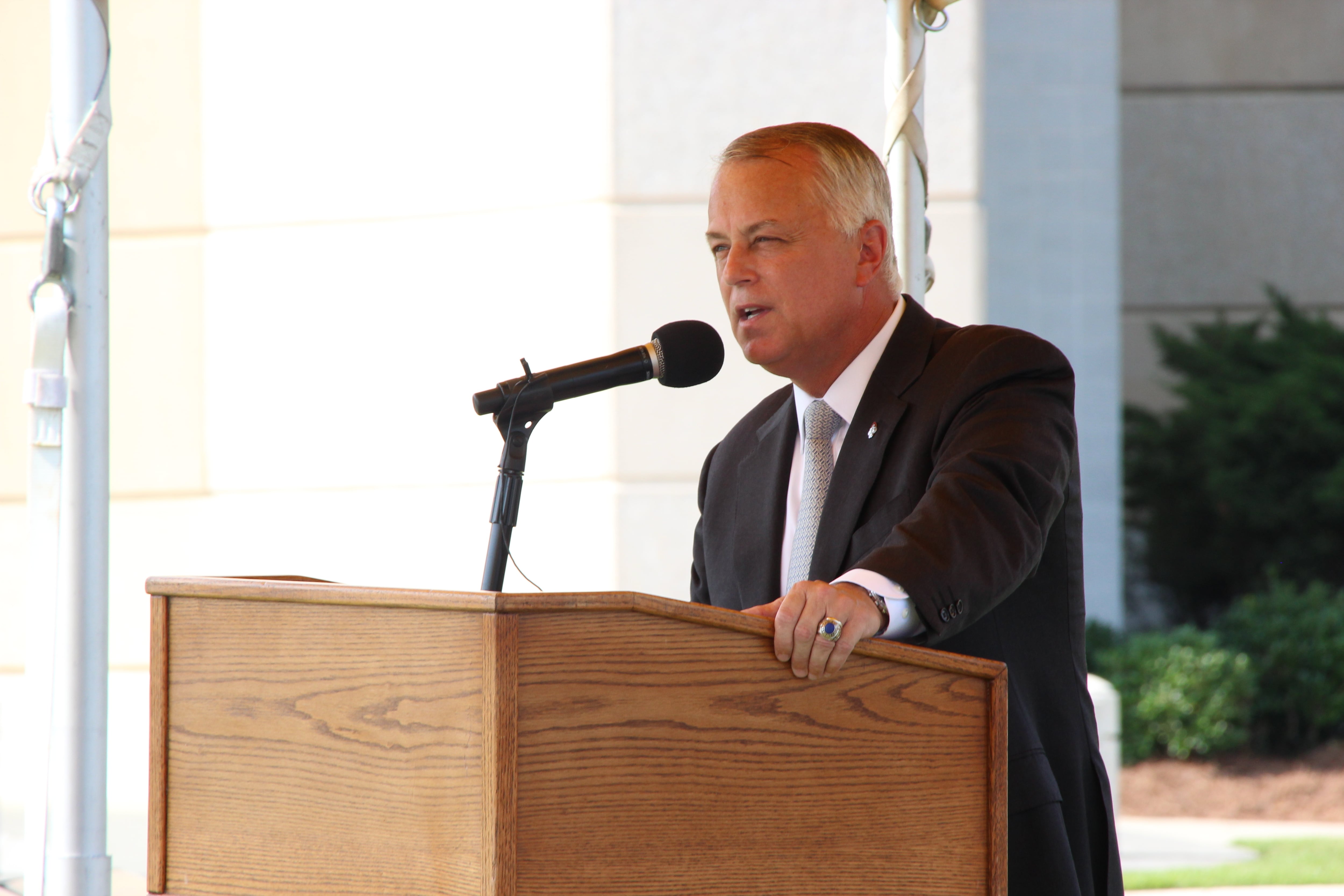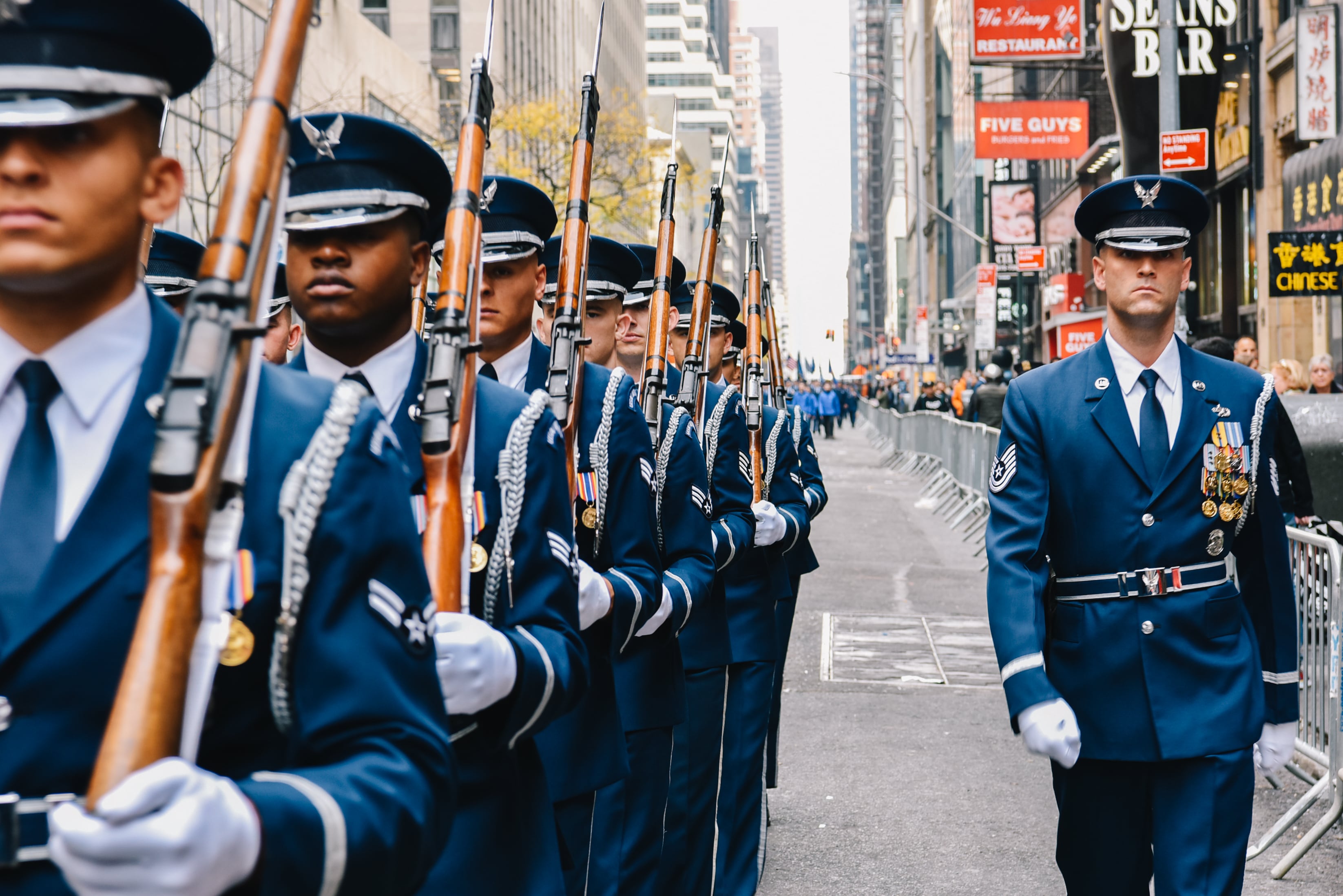FORT EUSTIS, Va. —Training officials are moving forward with several big changesto the service's enlisted schooling system thanks to the recommendations of thousands of soldiers who participated in one of the most ambitious polling efforts ever conducted by the Army.
The goal of the online NCO 2020 survey was to elicit opinions and recommendations from 400,000 Regular Army, National Guard and Army Reserve soldiers on issues relating to the redesign of the NCO Education System.
While the NCO 2020 project has timelines that stretch out five years, Sergeant Major of the Army Dan Dailey said he expects most components of the program will be implemented sooner, depending on funding and the budget process.
Programs slated for pilot evaluations and probable near-term implementation include:
• A mandatory writing assessment for the nearly 100,000 active and reserve soldiers who attend NCOES courses annually. Results of the survey indicated that writing is a major challenge for many NCOs, regardless of rank, and the assessment is designed to identify specific weaknesses so that leaders can guide soldiers into appropriate civilian education courses. School attendance would be voluntary, and can be paid for with Army Tuition Assistance.
• A new online assessment of military education topics is being developed so that soldiers can test out of previously learned or experienced material. The assessment responds to complaints from soldiers that NCOES topics frequently are redundant from one course to another. The assessment currently is being developed for the Warrior Leader Course, but the concept eventually will be expanded to other courses.
• The Warrior Leader Course is being evaluated for redesign, and probable shortening through a combination of distributed learning and resident instruction. Whatever the end result, it seems certain that the Warrior Leader Course will be renamed the Basic Leader Course.
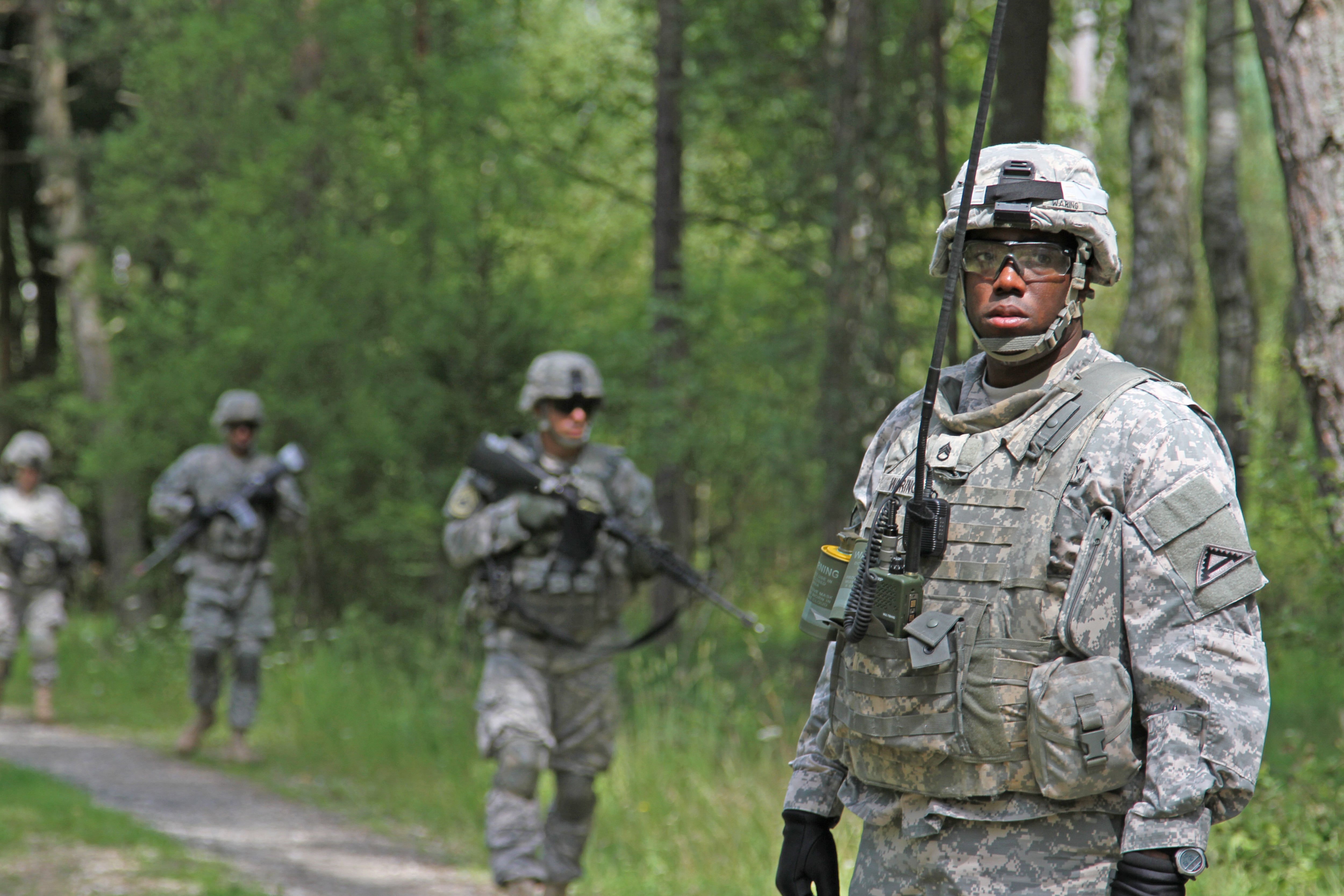
Staff Sgt. Jerome Waring, a small group leader with the 7th Army Noncommissioned Officer Academy, evaluates Warrior Leader Course students as they execute training missions Aug. 1 at the Grafenwoehr Training Area in Germany.
Photo Credit: Sgt. Christina Dion/Army
That is because research for the Soldier for Life program, and the Army's transition assistance program, indicates that the term "Warrior" does not resonate well with potential employers in the civilian sector.
• A Skill Level V course is being developed to prepare promotable sergeants first class for duties as master sergeants and first sergeants. The mandatory course will be non-MOS specific, and will fill the learning gap that exists now between the Senior Leader Course and the Sergeants Major Course. No word yet on how this course will affect promotion eligibility.
The NCO 2020 survey of two years ago had about 70 questions on all manner of professional military education.
Common themes among responses indicated that soldiers want to eliminate" check-the-box" training, and improve the rigor and reduce the redundancy in training.
Responses also indicated that soldiers need a more tailored approach to training, such as self-paced training, and that soldiers want more difficult training when it comes to their jobs.
Another important response was that job-related training frequently comes too late in the educational pipeline, after soldiers have experienced it on-the-job, or in earlier courses.
Dailey, who until recently was the command sergeant major of Training and Doctrine Command, said in redesigning NCOES, the Army is striving for a comprehensive, progressive and sequential system that provides soldiers with the knowledge, skills and attributes they need to accomplish their jobs.
Simultaneously the service is designing a system that will provide the educational credits and experience that will translate well in the civilian sector when they separate from service.
"Our goal is to maximize their civilian equivalency for their military requirements," Dailey said in a Jan. 28 interview at the Pentagon. "Let's say someone is a welder.How do we get that person certified, as well as providing them with academic equivalency?
"We're working with our partnering institutions, the ones we have been working with for years through GoArmyEd, to give our soldiers maximum credit," he said.
Finally, "we're going to add relevance and rigor" to NCOES, according to the new sergeant major of the Army.
"Things like second retest will probably go away in the future," he said.
"We need to raise academic standards, one, because analysis says we can, and two, because our noncommissioned officers are asking for it, and three it will make ourselves a better force.
"It'll have challenges, but it's the direction we need to go."
The writing assessment
"One thing we found out from the NCO 2020 survey was that for most noncommissioned officers, writing is a challenge," said Dr. Aubrey Butts, director of the NCO Institute of Professional Development.
"We can make assumptions why that is so, such as it could be because of the environment an individual grew up in, but we have no hard quantitative data on that."
However, Butts said having quantitative data may be less important than dealing with the challenge of helping soldiers improve their writing skills, an attribute that becomes increasingly important as the Army reorganizes into smaller units that will be widely dispersed, and that will require soldiers to communicate with their command structure.
To assist in that effort, the Army has identified a writing assessment -— already in use in the civilian sector — tool already in use in the civilian sector and academia to evaluate every NCO throughout his or her career each time they make contact with the NCO Education System.
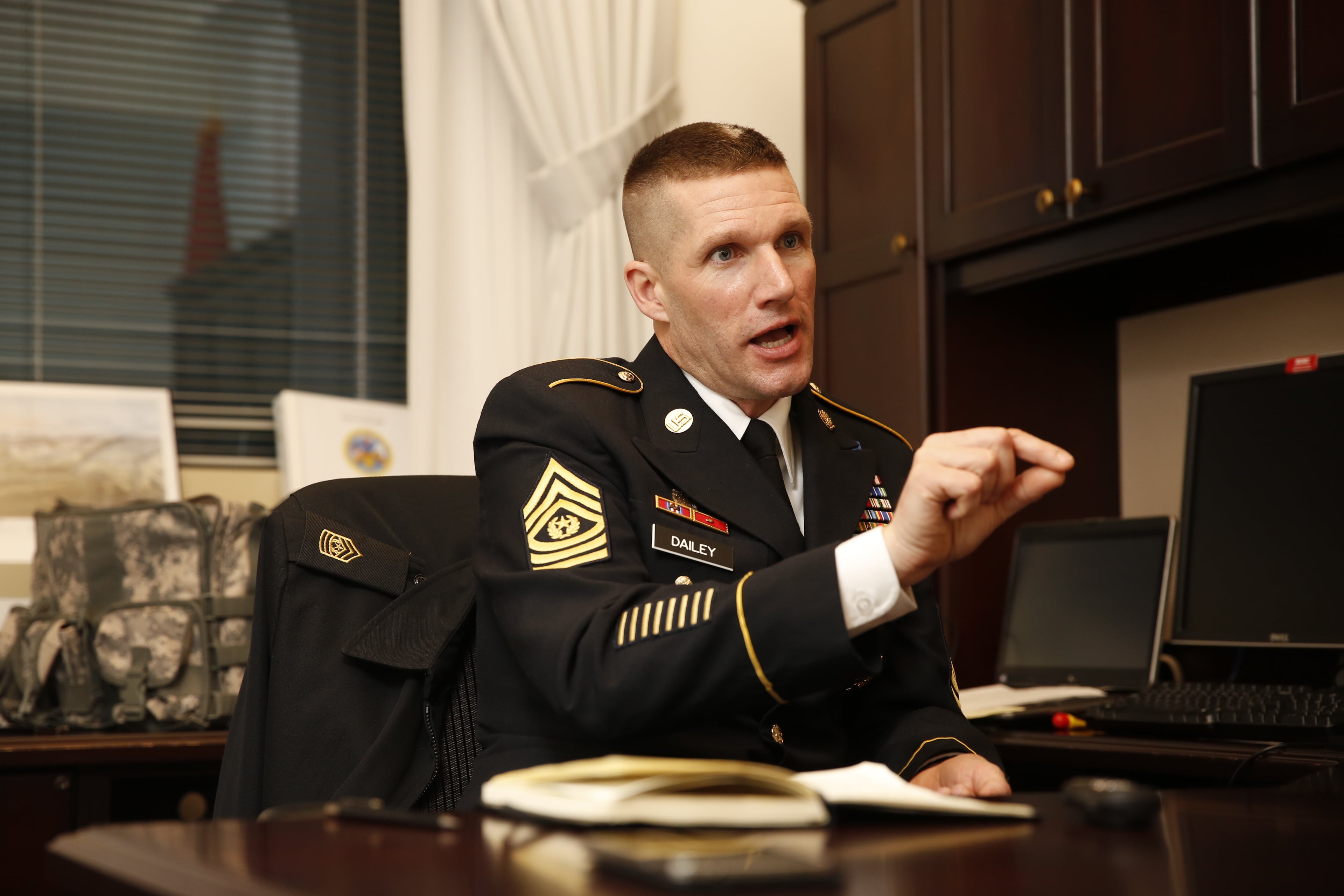
Sergeant Major of the Army Dan Dailey says changes to NCO schooling are intended to add "relevance and rigor."
Photo Credit: Mike Morones/Staff
Soldiers will be introduced to the essay challenge, called the Criterion Writing Assessment Tool, on the first day of the Warrior Leader Course, Advanced Leader Course, Senior Leader Course, Master Leader Course and the Sergeants Major Course.
The Criterion topic library has more than 400 essay assignments at various skill levels that can be used to evaluate soldiers.
"Soldiers will select a topic from the menu of available subjects, and write two paragraphs," Butts said.
Topic modes for these essays might include persuasive, informative, explanatory, informative, narrative, issue and argumentative.
Some specific essay assignments in the Criterion assessment for the 12th grade college prep level include:
• A graduating high school senior's advice to freshmen to help them have happy and productive years in high school.
• Some high schools require students to follow a dress code.Write a persuasive essay about the reasons for instituting dress codes, and why they might be needed.
• You have been contacted by a computer company to come up with an idea for a computer game that will be fun and teach a skill. Describe the kind of game you would design.
• Some students become disinterested in their high school experience because it is the "same old routine."Write an essay about what can be done to keep students motivated and focused on their studies.
• The Constitution requires that the president of the United States be born in the U.S.Do you believe the law should be changed to allow anyone to be president, regardless of place of birth?
The tool can score a soldier's essay within 10 seconds. The near-instantaneous feedback will address such issues as grammar, spelling, mechanics, usage, organization, development and other skills involved in writing effectively.
The exam will be administered to about 100,000 Regular Army, National Guard and Army Reserve soldiers annually.
Results of the exam will be added to a soldier's academic evaluation report, the DA Form 1059, and the Army Career Tracker, an online application for recording professional development information.
Because that information is officially recorded, it will be available to the soldier's chain of command, typically the first- and second-tier supervisors, and the unit commander.
If the recommendation of the assessment is that a soldier take a basic college English course, then the chain of command members might advise the soldier to contact a counselor at the local Army education center, and arrange to take an appropriate course through the Tuition Assistance program.
"With this type of information, we can focus Tuition Assistance to help the soldier while helping the Army by improving (his or her) written communication skills," Butts said.
"We don't want to take a lot of time from the education (process), but we know that for us to improve the communication skills of American soldiers, the assessment is a must."
The tool is an off-the-shelf product of the Educational Testing Service, a non-profit organization that produces the Scholastic Aptitude Test and the Graduate Record Examinations. It's been used by Princeton University and many other respected educational institutions in the civilian sector.
The Army will conduct a pilot of the assessment tool in March and part of April at four Warrior Leader Course locations, and an Advanced Leader Course and Senior Leader Course for comparative data, according to Sgt. Maj. James H. Thomson, INCOPD sergeant major.
"By the end of May we should have the analysis of the results completed," Thomson said.
Any follow-up measures that a soldier takes after receiving his or her assessment results will be strictly voluntary.
"The beauty of this is that it allows us to drive behavior in the self-development learning domain," Thomson said.
"Right now (self-development) is up to the individual, but with this assessment we will be able to identify the weaknesses, and if the recommendation is English 101 then we will encourage the soldier to do that."
Butts said this approach is really different from the current system of assessment for professional military education, in which soldiers frequently use an open book to fill in the blanks.
Butts said that the rote memory learning process is not conducive to developing creative leaders.
"From what we have taught them, they should be able to write a paper, but we can't get there today. And we can't get there unless we give the soldiers the tools to do that," he said.
Butts said the online assessment is the same assessment used in the civilian sector, and does not have Army- or military-specific content.
"The same attributes that are needed for a college student, are the same attributes needed by our soldiers," he said.
"We aren't going after writing about the Army, we're going after writing," Butts said.
"In the Warrior Leader Course soldiers will be evaluated like they are in the first year of college, the Advanced Leader Course the second year, the Senior Leader Course the third year, the Master Leader Course the fourth year, and when they are at the SMC the Graduate Record Exam level of writing."
Responses to these tests will be made by soldiers in coordination with their chain of command, not from a program of instruction issued by the Training and Doctrine Command, officials said.
Once the writing assessment program is established, the annual target population will include nearly 100,000 NCOs of the active and reserve components.
Because the target population is so large, the Army will receive the service at the bargain price of $1.16 per assessment.
"You can't even have breakfast in the mess hall for that," Butts said, "but look at what it's going to get us."
Results of the NCO 2020 survey indicated that soldiers wanted the Army to improve the rigor and relevance of topics addressed in NCO Education System courses.
"In order for us to increase the rigor of NCOES, we must enhance the creative skills of soldiers, and their ability to express their thoughts on paper," Butts said.
Ability to test out
Respondents to the NCO 2020 survey clearly indicated that soldiers want to eliminate redundancies in military education courses, while favoring an increase in the rigor and timeliness of subjects being taught in the various NCO Education System courses. TRADOC officials are taking recommendations to reduce rendundancy seriously, and are designing a fix through a program with the ungainly name of the Army Distributed Online Collaborative Course, or ARDOCC.
Within its framework of the evolving course, tailored learning for individuals will be enabled by allowing soldiers will be able to test out of previously learned material by taking an assessment before beginning a required course, such as the Warrior Leader Course.
The ARDOCC will be an online course similar to the collaborative courses offered by colleges that allow students to have discussions with instructors and take learning assessments that allow them to test out of things they already know, according to Dr. Liston Bailey, chief of the INCOPD's learning and initiatives division.
"If there is a module on risk assessment, and I already know about that, I can take a pretest, and if I pass, I can move on to other objectives in the course," Bailey said.
The learning experience under ARDOCC will be self-paced, tailored and entered on the soldier's Army training record.
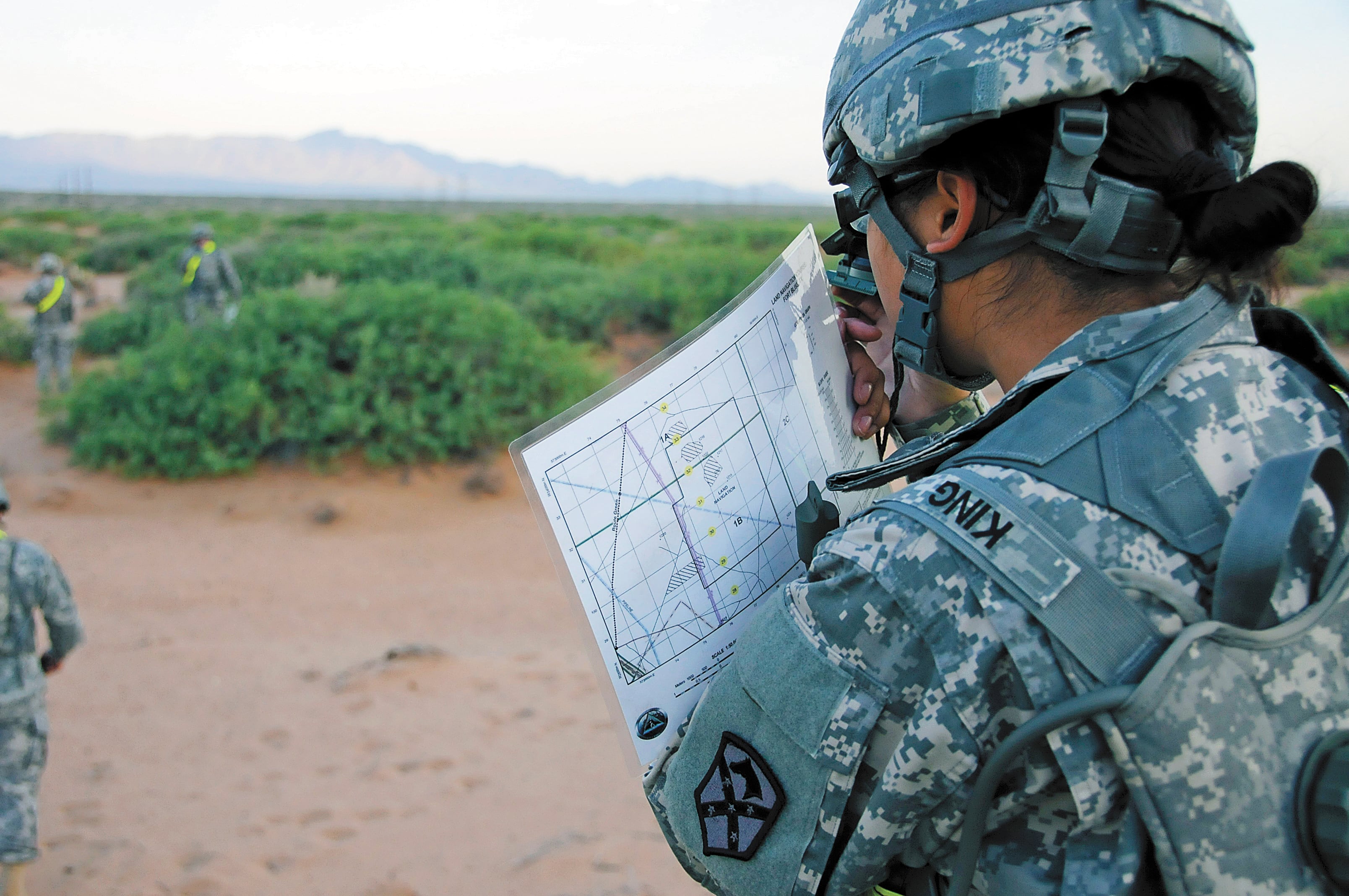
Warrior Leaders Course students conduct land navigation. The Army plans to offer soldiers the ability to "test out" of certain training to prevent redundancy.
Photo Credit: Ashley K. Arnett/Army
This represents a big change in training strategy, because today soldiers are required to take all modules or components of a course, Bailey said.
"This will become quite common for online training in the Army, with most schools going to a model like this so that students will feel more empowered in their learning," he said.
TRADOC officials are working with service schools and branch and military occupational specialty proponents to make this model come to fruition, most likely in conjunction with changes to the Warrior Leader Course.
Under one proposed course of action, Structured Self Development-1, which is the 80-hour online pre-requisite for Warrior Leader Course attendance, would be replaced by ARDOCC, and would allow test out options for students.
A second proposed action would keep SSD-1, followed by an ARDOCC that would allow soldiers to test out of certain material in the resident phase of the Warrior Leader Course.
Warrior Leader changes
The Institute of NCO Professional Development is conducting a review of the Warrior Leader Course with a view to possibly changing the way the Army delivers this entry level leadership development course for enlisted soldiers.
WLC, which likely will be renamed the Basic Leader Course, currently has a 22-day resident program of instruction, not include the online SSD-1 prerequisite phase. The course is taught at NCO academies throughout the Army, with a standard curriculum for active and reserve soldiers from all MOS.
Under a policy that links promotions to completion of various professional military education courses, WLC is a requirement for enrollment in SSD-2, which in turn is a requirement to be boarded for advancement to staff sergeant.
Possible changes in course design are focused on increasing the use of technology for delivering.
"Instead of having a talking head out in front of the class, maybe we will have three short videos to introduce a subject, with facilitation by an instructor," Butts said.
"This then will be followed by a longer video that will get to the main points we want to emphasize."
The NCO institute is partnering with the Asymmetric Warfare Group, the Training Brain Operations Center and the Combined Arms Center-Training organization to plot a possible path away from traditional teaching methods that will cultivate tailored learning for the soldiers attending WLC.
As an example of that approach, Butts said "we could possibly take every student in a WLC class, which can be up to 190 people, and have one guy (the instructor) with a central computer monitor and track every student."
Assistant instructors would then go to individual students and help them as needed.
"Instead of trying to help everybody, we will go to students who need help.We don't need to change our business, but how we do business to make it more effective and efficient," Butts said.
"The typical young soldier today is a person who has attended civilian schools where they have been exposed to advanced technology and digital devices, and they come into the Army where an instructor is standing before them with a Power Point slide," Butts said.
"Soldiers don't understand that. They expect the Army to be a place of high technology, and that really resonates with them."
"We don't need to change our business, but how we do business to make it more effective and efficient," Butts said.
Officials do not anticipate any major changes in the topics to be addressed in WLC, as these involve basic soldiering and leadership skills, such as evaluations, military justice, counseling, training management, tactical operations, combat orders, map reading, land navigation, casualty evacuations, team and squad movements and health and fitness.
However, officials indicate that some subjects now covered in WLC, such as drill and ceremonies, portions of map reading and land navigation, and certain mandatory training, could be moved to SSD-1 and the Army Distributed Online Collaborative Course.
Officials emphasized that while the possible redesign of this course continues, the end result "will not" be separate courses for the active and reserve components.
Both the National Guard and Army Reserve have indicated they support one course for all components, Thomson said.
Master Leader Course
The Army is preparing to fill a training void for that has long neglected the senior NCOs who serve in some of the most demanding leadership positions at the company- and battalion-level across the active and reserve components.
"Soldiers serving in the grade of E-8 are very important to the Army, because they either are staff NCOs that advise senior commanders, or they are a first sergeant, and the top-ranking NCO in company-level units," said Butts.
"We have not been providing these soldiers with the skills they need to perform those jobs."
"These soldiers need entry-level, executive decision-making tools, (but without a dedicated training course) they will have to rely on their training and experience as platoon sergeants,' Butts said.
While noting the Army used to have a first sergeant course, Butts said the service never has fielded a course for its entire population of master sergeants.
A non-MOS specific Skill Level 5 professional military education course that will be mandatory for promotable sergeants first class is on the drawing boards, and likely will be placed on a path to activation later this year after senior leaders are briefed on the project, according to Thomson.
The annual training requirement for the new course, to be called the Master Leader Course, is 4,300, with about 50 percent of those soldiers coming from the Regular Army, one-third from the National Guard and the remainder from the Army Reserve and the Active Guard and Reserve.
Curriculum components will be designed to challenge and educate master sergeants in the areas of professional writing, communication skills, public speaking, organizational and command leadership, management skills in a joint environment, the operational level of warfighting, enhancing the discipline, readiness and health of soldiers, and a focus on the administrative requirements of unit management.
Students also will be exposed to such topics as national security, interagency and multinational operations and strategic critical thinking.
"For most of these soldiers, their jobs will involve duties on senior-level staffs, and for the first time in their careers many will be serving at the organizational, and even strategic, leadership levels," Butts said.
There are different ways that the new course can be delivered, including:
• A two-week resident course that everyone attends.
• A course that is delivered periodically at select NCO academies around the Army.
• A combination of distributed learning and a short resident phase.
Gen. Ray Odierno, Army chief of staff, is scheduled to be briefed on this initiative in the spring, which could lead to decisions on a specific format and the fielding of a pilot course later in the year.
Officials indicated that once the Master Leader Course is fielded, SSD-4 could become a prerequisite for attendance, while the Joint Professional Military Education course could become a prerequisite for the Sergeants Major Course.
However, officials indicated that decisions on these matters will made in the future by senior Army leaders.
Staff writer Michelle Tan contributed to this report.


